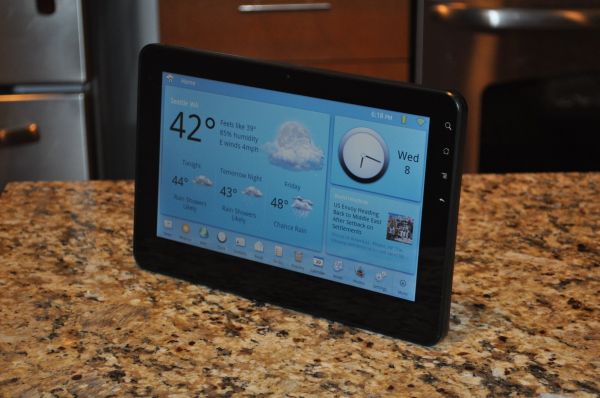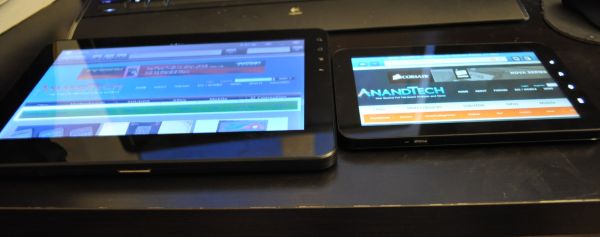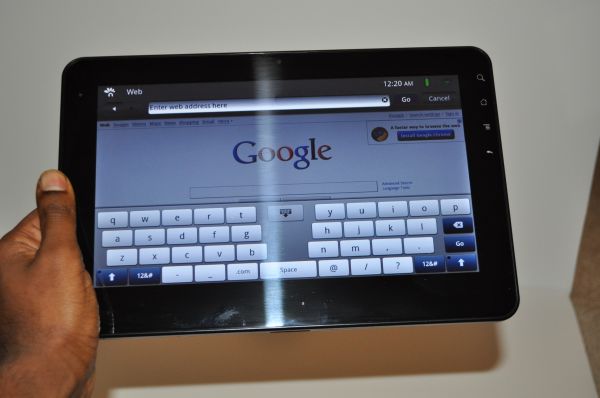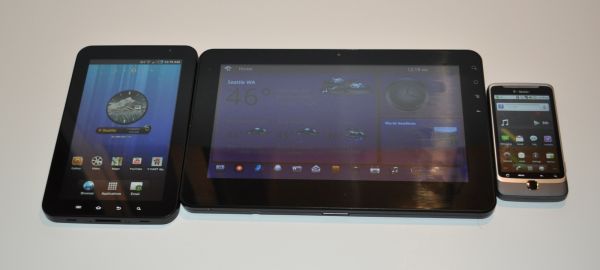First Look: Viewsonic G Tablet and Tegra 2 Performance Preview
by Vivek Gowri on December 9, 2010 3:04 AM ESTThe slate computing market is about to explode, with a literal flood of new tablets releasing over the coming months. Many of them will be Android based, running Nvidia’s Tegra 2 SoC. Nvidia made a big deal about Tegra 2 back at CES 2010, but for some reason, it’s taken quite a bit of time for anything running the platform to hit the market. Finally, we have one - the Viewsonic G Tablet.
The Tegra 2-based Viewsonic G Tablet showing the Tap UI homescreen
The specs are pretty straightforward; we’ve got a 10” WSVGA display with LED backlighting, Android 2.2 with a specialized UI skin on top, a 16GB microSD card, 2.4GHz 802.11n, Bluetooth 2.1, a 27 Whr lithium ion battery, and the Tegra 2 SoC. The dual-core Cortex A9 is clocked at a nice, round 1 GHz, and there’s 512MB of LPDDR RAM on board. The GPU is Nvidia’s Ultra-Low Power GeForce GPU and there are separate HD video encode and decode blocks also onboard. But the big deal with Tegra 2, as Anand went over in his first look at the SoC, is Cortex A9. The A9 is an out of order architecture with a relatively short pipeline, so it should be significantly faster than the in-order A8 on a per-clock basis.
But before we get to the performance aspect, let’s give the tablet a once over. The Viewsonic is not the most interesting physical specimen, just a screen with a thin bezel around it. From the front, it looks nearly identical to the Galaxy Tab and any number of other tablets on the market. The sides are pretty plain, with volume buttons at the top and a dock connector and mic at the bottom. The left side has a mini USB port, a headphone jack, and a power jack, while there are speakers on either side. The back is filled with logos - Viewsonic, the gTablet logo, the American distributor’s logo, barcode, FCC ID, etc - but otherwise pretty plain. Build quality is actually pretty decent and the tablet has a pretty weighty feel in hand. There’s no flex anywhere, and while the casing doesn’t feel particularly high quality, it’s not low quality by any means. There are some touches in the industrial design that make it seem a bit cheap. The capacitive touch buttons are off-center and easy to press inadvertently, and the physical buttons are placed pretty haphazardly. One thing that really threw me off is the volume rocker, which is switched from the logical layout (volume up is the lower button, volume down is the upper button).
The Viewsonic (left) next to the Samsung Galaxy Tab, both on maximum brightness, to illustrate the viewing angles of both tablets
But for $399 for a Tegra 2 tablet, minor quibbles about build quality and industrial design are about what one should expect. I also expected a not-so-great screen, but not like this. I know that not everyone can splurge like Apple did and go for an IPS screen, but when you look at the TN panels in these and other tablets, it really does make sense. The problem isn’t contrast ratio, the 432:1 figure is actually pretty good for a netbook screen and much better than most small notebooks. It doesn't match the iPad's amazing 934:1 contrast ratio, but still, contrast is not the problem. Unfortunately, the max brightness is not that high at 186nits, which only exacerbates the terrible viewing angles. Something I’ve realized in using tablets - the viewing angles matter a whole lot more than they do in laptops. As is typical with widescreen displays, the horizontal viewing angle is decent, but the vertical viewing angle is pretty bad - anything more than 30 degrees off center and the screen completely washes out. If I try to lay it flat on my desk and use it like my iPad or the Galaxy Tab, it’s basically impossible to see anything on the screen. For a device with a usage model so heavily dependant on good off-center viewing angles, speccing a screen with poor viewing angles was a pretty big oversight.
Viewsonic's Tap UI landscape split keyboard in the revised browser interface
Viewsonic loaded their own Tap UI onto the G Tablet. It’s a decent looking UI, but it’s aggravatingly slow and makes most of the navigation through the OS pretty painful. As with most tablets, there’s no Market preinstalled on the G Tablet (Samsung is the exception here, since they have managed to work around the Android Market restrictions). However, the XDA developers forum is your friend - there’s a simple workaround to get Market and other Google applications enabled, and it’s also possible to disable the UI skin. We’ll go over the software package and hacking aspects of the G Tablet in the full review; for now just know that the preloaded UI is pretty terrible, you'll want to disable it as soon as possible.
The G Tablet (center) next to the Galaxy Tab (left) and T-Mobile G2 (right)
Our first impressions of the G Tablet, beyond the woeful viewing angles and the unfortunate UI skin, is actually that of a fairly usable budget tablet. The user experience is actually pretty decent once you get out of the main UI and into an app or a browser window, and the split keyboard in landscape mode is much better than expected. The tablet has a nice, weighty feel in hand, but if you're using it in landscape mode, it might feel a little heavy for one-handed operation. The touchscreen is responsive enough, though it doesn't feel quite as sensitive as the Galaxy Tab or the iPad. That could just be because of the overall sluggishness of the UI, but we'll see about that after I load the stock Android UI onto the G Tablet. We'll see, but at first brush it looks like the main problems with the Viewsonic are the screen and the UI. We'll have a full review later on with more complete impressions and battery life numbers, but for now, we'll leave you with a preview of Tegra 2 performance.




















78 Comments
View All Comments
xipo - Thursday, December 9, 2010 - link
after looking the way the Google Nexus One performes with an old Snapdragon QSD8250, one can only wish there where a Google Nexus TAB :D that would be a mayor win... because clearly the hardware is worthless without proper software optimization.. so, you should update this charts as soon as the google nexus S comes out.Ben90 - Thursday, December 9, 2010 - link
If the Linpack algorithms are the same. An overclocked i7 system is over 1000 times faster than these tablets. Obviously you would expect an i7 system to be faster, but it just puts it into perspective.metafor - Thursday, December 9, 2010 - link
Linpack implementations on desktops also use Intel's optimized SSE library. A similar NEON implementation should show significant improvements.Also, the memory subsystem on desktops is ridiculously fast compared to a smartphone.
name99 - Thursday, December 9, 2010 - link
There is a NEON-optimized LINPACK as part of iOS 4.It would have been nice if someone had bothered to investigate this issue to get some numbers for it. If only there were some way to search the internet on this subject ... Oh wait...
There is a Linpack app on the iTunes store that is a very thin wrapper around the Apple code. Running it on my iPad, I get 38.67 LINPACK Mflops/s.
name99 - Thursday, December 9, 2010 - link
Actually I read the Linpack report incorrectly. The mean result (averaged over 50 runs) was around 41.8 Mflops/s. The number I reported was simply the result of the very last run.There was quite a bit of scatter in the results, with the fastest coming in at just under 50 Mflops/s. I'm not sure quite what is happening here --- the most obvious assumption is OS scheduling and interrupts, and that whatever timer is being used to calculate the results is tracking wall time, not process time.
metafor - Friday, December 10, 2010 - link
The comment was regarding scores on Android phones. Also, those are quite low if they truly take use of NEON. But the A8's FPU isn't known for speed.name99 - Friday, December 10, 2010 - link
Jesus dude, the article is titled First Look at Viewsonic TABLET.And regardless of how bad Apple's NEON LINPACK may be (it apparently matches Google's implementation in that they get comparable results on comparable hardware) the fact is the implementation exists, which is more than can be said for some phones.
Are you so desperate to hate Apple that you need to clutch at straws like this? There are plenty of real things to criticize in the iOS world without being just stupid.
metafor - Monday, December 13, 2010 - link
I believe you're the only one who's mentioned Apple.My comment was about Linpack on Android and how (since it runs on a VM), it doesn't utilize NEON. As you so pointed out, a native implementation on the same processor (Hummingbird) produces better results.
Still, the end results are quite low compared to what could be expected from the hardware, suggesting further software optimization is necessary before a comparison to the desktop.
Genx87 - Thursday, December 9, 2010 - link
It will be interesting to see how much power this consumes. I suspect the i7 system may consume 1000 times more power as well ;)synaesthetic - Monday, December 20, 2010 - link
Much more than 1000 times, actually. :)